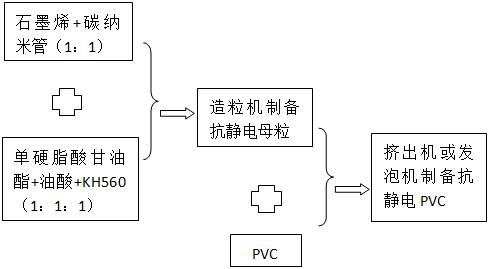Long-acting antistatic foamed polyvinyl chloride
A polyvinyl chloride, antistatic technology, applied in the field of long-term antistatic foamed polyvinyl chloride, can solve the problems of surface cell structure discontinuity, easy to generate static electricity, etc.
- Summary
- Abstract
- Description
- Claims
- Application Information
AI Technical Summary
Problems solved by technology
Method used
Image
Examples
preparation example Construction
[0021] Liu Yi and others studied the preparation and research of antistatic PVC (Green Packaging Research, 2016, 4:35-37), and analyzed the influence of external coating materials on antistatic properties. Wang Kefeng and others studied the antistatic performance of PVC flame-retardant conveyor belts for coal mines (Henan Chemical Industry, 2011, 24(9): 29-31), and the results showed that adding certain non-ionic surfactants KJ-210 and conductive acetylene black to PVC It can improve the antistatic performance of PVC, and also improve the flame retardant performance of PVC. The addition of nano-carbon materials will also affect the mechanical properties of PVC. Cheng Bo et al.’s research on the properties of nano-graphite microflakes shows that with the increase of graphite flake content in PVC, its mechanical properties first increase and then decrease. This should be It is caused by the interaction of PVC and graphite flakes. Hu Shu et al. reviewed the mechanism and applica...
Embodiment 1
[0043] 1. Mix 2 kg of glyceryl monostearate, oleic acid, and KH560 at a mass ratio of 1:1:1 at 150°C to obtain a surfactant.
[0044] 2. Add a specific surface area of 180 m to the molten surfactant 2 / g of reduced graphene oxide with a specific surface area of 200 m 2 Each 1000 g of carbon nanotubes / g was fully mixed, and the surfactant was fully adsorbed on the surface of reduced graphene oxide and carbon nanotubes.
[0045] 3. Mix the mixture prepared in 2 and 20 kg PVC in the mixer evenly, and then enter the granulator for granulation. The working temperature of the granulator is 150 ℃, and the particle size of the obtained antistatic mesh granules is Φ3× 5 (mm) cylindrical particles. In order to improve the dispersion uniformity of reduced graphene oxide and carbon nanotubes in polyvinyl chloride, the prepared masterbatch can be subjected to secondary granulation to obtain a masterbatch with uniformly dispersed components.
[0046] 4. Fully mix the antistatic maste...
Embodiment 2
[0049] 1. The specific surface area is 60 m 2 / g of reduced graphene oxide, with a specific surface area of 130 m 2 / g of carbon nanotubes, the ratio of the two is 1:1.2, and 2 kg of the homogeneous mixture is prepared for use.
[0050] 2. Take 2 kg of glyceryl monostearate, oleic acid and KH560 surfactant with a mass ratio of 1:1:1, and mix them thoroughly with 2 kg of the mixture material.
[0051] 3. Take 2 kg of the mixture prepared in step 2 and 20 kg of PVC and mix them thoroughly in a mixer, then granulate in a granulator to obtain an antistatic masterbatch of Φ3×5 (mm).
[0052] 4. Take the antistatic masterbatch and polyvinyl chloride according to the mass ratio of 1:8 and 1:15 and then foam them separately to obtain two kinds of foamed polyvinyl chloride. The surface resistance of the prepared foamed polyvinyl chloride 50 ohms and 660 ohms respectively.
[0053] 5. After the prepared foamed antistatic PVC is placed under natural conditions indoors for 30 days, t...
PUM
| Property | Measurement | Unit |
|---|---|---|
| Specific surface area | aaaaa | aaaaa |
| Specific surface area | aaaaa | aaaaa |
| Surface resistance | aaaaa | aaaaa |
Abstract
Description
Claims
Application Information
 Login to View More
Login to View More - R&D
- Intellectual Property
- Life Sciences
- Materials
- Tech Scout
- Unparalleled Data Quality
- Higher Quality Content
- 60% Fewer Hallucinations
Browse by: Latest US Patents, China's latest patents, Technical Efficacy Thesaurus, Application Domain, Technology Topic, Popular Technical Reports.
© 2025 PatSnap. All rights reserved.Legal|Privacy policy|Modern Slavery Act Transparency Statement|Sitemap|About US| Contact US: help@patsnap.com

